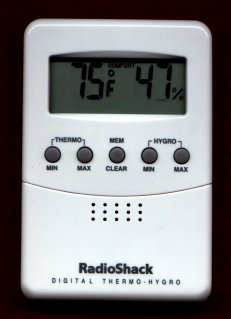The first part of this page is going to deal with how I monitor humidity and the instruments used. It is not my intent to talk in detail about the science of humidity, but to inform the reader how to use the instruments.
 Let's take a look at the scientific instruments that we need to get started. I consider these instruments to be essential:
Let's take a look at the scientific instruments that we need to get started. I consider these instruments to be essential:
At the top of this photo is a sling psychrometer.
In the middle we have a hygrometer
At the bottom we have a psychrometric slide rule.
Now let's see how these instruments are used and why.
Sling Psychrometer. This instrument consists of two thermometers, a dry bulb and a wet bulb. The dry bulb measures actual air temperature, and the wet bulb which measures the water vapor in the air. The wicking attached to the wet bulb thermometer is immersed in water.
 When using a sling psychrometer it is necessary to whirl the instrument for about ten seconds, two or three times, until there is no further drop in temperature, before readings are taken.
When using a sling psychrometer it is necessary to whirl the instrument for about ten seconds, two or three times, until there is no further drop in temperature, before readings are taken.
To find the percentage of relative humidity I use a psychrometric slide rule.
Psychrometric Slide Rule. The psychrometric slide rule is used to quickly determine the percentage of relative humidity. The readings from the sling psychrometer are noted. Then the slide rule is set so that the wet bulb reading coincides with the dry bulb reading. The percentage of relative humidity is shown at the arrow. For example dry bulb, bottom row, = 80 degrees, wet bulb, top row, = 67 degrees, the relative humidity at the arrow is 50%. Now we calibrate our hygrometer, as long as it is in the same room that the readings of the sling psychrometer where taken in.

Hygrometer. This device is used to monitor the relative humidity levels. You do not need to spend a lot of money on a hygrometer. I purchase mine from woodworker's catalogs. The cost can vary from $5.99 to $11.99. They can easily be calibrated by carefully using a screw driver to move the element on the back. The gauge should be monitored throughout the day until it keeps it's calibration. After that you only need to calibrate once a month. Once a year I set my gauges on a towel on the floor in the bathroom and turn the hot water on in the shower until the room gets steamy. Then I turn the shower off and let the gauges sit for 1/2 an hour or more. This "charges" the hygrometers for another year of use.

Here is a photo of the back of a hygrometer. When calibrating be carefull not to damage the element. The element is usually attached to a plate that can be moved around with the edge of a screw driver.
 This is an electronic hygrometer that is sold by Radio Shack. The only problem I have with this hygrometer is that it can not be calibrated. My tests have shown them to be off by 5%-10%. This makes this hygrometer totally unreliable in my shop.
This is an electronic hygrometer that is sold by Radio Shack. The only problem I have with this hygrometer is that it can not be calibrated. My tests have shown them to be off by 5%-10%. This makes this hygrometer totally unreliable in my shop.